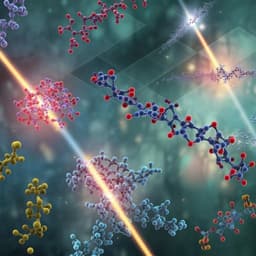
Chemistry
Singlet fission as a polarized spin generator for dynamic nuclear polarization
Y. Kawashima, T. Hamachi, et al.
This exciting research, conducted by Yusuke Kawashima and colleagues, reveals how singlet fission can enhance the sensitivity of magnetic resonance in water molecules. By utilizing supramolecular assemblies of pentacene chromophores, they demonstrate the remarkable potential of generating polarized spin for bio-quantum technology applications.
~3 min • Beginner • English
Introduction
Photo-excited states in organic assemblies enable unique optoelectronic functions due to singlet and triplet excitons. Singlet fission (SF) converts one singlet exciton (S1) into a pair of triplet excitons (TT), which can form a high-spin quintet state (5TT). While SF has been explored for photovoltaics as a route to surpass single-junction efficiency limits, its spin degrees of freedom remain underutilized. The basic SF pathway is S1 → 1(TT) followed by intersystem crossing to 5(TT); in larger assemblies, dissociation to free triplets can occur. Theory (JDE model) predicts that appropriate exchange coupling and alignment can preferentially populate the (5TT)0 sublevel as a nearly pure quantum state. In quantum technologies, particularly dynamic nuclear polarization (DNP), polarized electron spins can dramatically increase NMR/MRI sensitivity, but conventional cryogenic DNP using radicals is complex and costly. Photoexcited triplet-based DNP has been demonstrated, yet typical triplet polarization is far below 100%. SF offers a route to higher polarization by preferentially populating specific quintet sublevels through structural control of chromophore dimers. This study tests the hypothesis that SF-generated, spin-polarized quintet multiexcitons can serve as efficient polarized spin sources to hyperpolarize nuclei (protons) in a biologically relevant water-glycerol glass matrix, and examines how supramolecular assembly and chromophore interactions govern SF, electron spin polarization, and nuclear hyperpolarization.
Literature Review
Prior SF studies have focused on exciton multiplication for solar energy conversion and on microscopic mechanistic understanding of spin dynamics, including the role of exchange coupling, molecular orientation, and vibronic effects in generating and stabilizing 5(TT) sublevels. The JDE model explains preferential population of (5TT)0 in oriented dimers with strong exchange coupling and parallel principal axes to the Zeeman field, consistent with crystalline samples. In DNP, traditional approaches transfer polarization from radicals at cryogenic temperatures (~1 K), enabling clinical MRI probes but requiring complex infrastructure. Photo-induced triplet DNP has been explored as a higher-temperature alternative, though triplet polarization is typically far from unity. Cyclodextrins (βCD, γCD) are established hosts for hydrophobic molecules and can modulate chromophore aggregation and excitonic coupling. Literature also documents how small geometric displacements in closely packed dimers switch between J- and H-aggregate-like behavior due to orbital overlap, and how coherent/incoherent SF dynamics arise from strong electronic interactions and structural fluctuations. These works motivate engineering discrete pentacene dimers with controlled coupling to harness SF-born quintet polarization for DNP.
Methodology
- Materials and assembly: Used amphiphilic sodium 4,4'-(pentacene-6,13-diyl) dibenzoate (NaPDBA) (1 mM). Solutions prepared in methanol (monomeric) and in water-glycerol (1:1 v/v) for glass formation under DNP-relevant conditions. Supramolecular control via cyclodextrins: β-cyclodextrin (βCD) and γ-cyclodextrin (γCD) added (NaPDBA 1 mM; CD 5 mM) to modulate interchromophore coupling.
- Structural characterization: UV–vis absorption measured at room temperature and 143 K. Dynamic light scattering (DLS) assessed aggregate sizes. Molecular dynamics (MD) simulations performed for 20 NaPDBA molecules in water-glycerol (300 K) and for 2:2 NaPDBA–γCD inclusion complexes (243 K); analyzed center-of-mass distances and orientations, and potential of mean force (PMF) for stability.
- Transient absorption spectroscopy (TAS): fs-TAS and ns-TAS on vitrified water-glycerol glass at 143 K. Excitation near absorption edge (600–635 nm; or 500/600 nm via OPA/OPO). Probed 450–750 nm. Global analyses with sequential kinetic models extracted time constants and evolution-associated spectra (EAS).
- Time-resolved ESR: Home-built X-band (~9 GHz) spectrometer. Samples in glass capillaries, water-glycerol glass at 143 K; pulsed 527 nm excitation. ESR spectra analyzed and simulated as superpositions of ISC-born triplets and SF-born quintets using a geometric fluctuation model with two strongly coupled TT conformations (TTA, TTB) differing in J-coupling and orientation.
- DNP experiments: Home-built Ku-band (~17.3 GHz) ISE setup. Matrix: glycerol-d8:D2O:H2O = 5:4:1, at 100 K. Polarization source: photoexcited spins generated by 527 nm laser (1.5–2.7 W, typically 500 Hz). ISE sequence applied with simultaneous microwave irradiation (continuous wave gated by PIN diode; up to 20 W) and magnetic field sweep (~10 mT; triangular waveform, tens of μs). Central magnetic fields chosen to match ESR peaks (e.g., 629 mT for quintet). Proton NMR detected with magic-echo due to short T2 in solids. Compared DNP profiles to ESR spectra integrated over 10 μs to match the ISE window. Assessed microwave power dependence to test Hartmann–Hahn matching for triplet vs quintet (different Rabi frequencies).
- Controls: NaPDBA–βCD complexes (monomeric dispersion) assessed as negative control for SF/quintet formation; room-temperature water samples examined to distinguish effects of CD complexation vs temperature; excitation wavelength dependence checked.
Key Findings
- Supramolecular assembly control:
- In water-glycerol (1:1), NaPDBA absorption red-shifts from 593.5 nm (methanol) to 604 nm, indicating small dimer formation; DLS shows no large aggregates; MD reveals multiple dimers plus monomers at 300 K.
- γCD complexation produces further red-shift and broadening upon cooling to 143 K (peak ~612 nm), consistent with stronger interchromophore coupling. NMR and MD support a 2:2 NaPDBA–γCD inclusion complex stable at 243 K, with closer, less fluctuating dimer geometries.
- βCD complexation disperses NaPDBA monomers; negligible excitonic coupling and SF.
- Evidence and dynamics of singlet fission:
- NaPDBA dimers (water-glycerol glass, 143 K): fs-TAS shows decay of S1 features (430–450 nm) and growth of triplet TA (510–520 nm). Global fit (2-component sequential) yields S1 → 1(TT)/T1 formation time constant 2.65 ± 0.01 ps; long-lived T1 (>1 ns). ns-TAS shows slower T1 growth from ISC for monomers, indicating coexistence of monomeric and dimeric species.
- NaPDBA–γCD: prompt appearance of 510–520 nm features with distinct initial spectra; global fit (3-component sequential) indicates initial mixed [S1–TT] adiabatic state followed by [S1–TT] → TT* in 0.79 ± 0.01 ps, then relaxation TT* → TTd in 96 ± 1 ps. Spectral shifts suggest strong coupling and possible coherent/incoherent SF contributions.
- NaPDBA–βCD: negligible SF observed.
- Quintet spin generation (ESR):
- Time-resolved ESR detects quintet signals with linewidths ~1/3 of triplet in NaPDBA dimers and NaPDBA–γCD; spectra fit by superposition of ISC-born triplets and SF-born quintets using two TT conformations (parallel and slightly off-parallel). Preferential population of 5(TT)0 (and other sublevels) inferred; largest ESR when B0 parallel to pentacene backbone. No significant contribution from dissociated triplets; consistent with dimer formation.
- Quintet polarization lifetimes: 5.5 μs (NaPDBA dimers) and 1.8 μs (NaPDBA–γCD), sufficient for DNP. βCD samples show only ISC triplet, no quintet.
- DNP of water-glycerol using SF-born quintet polarization:
- Clear 1H NMR signal enhancement at magnetic fields matching quintet ESR peaks for NaPDBA dimers and NaPDBA–γCD; no enhancement at quintet field for βCD control.
- Overall proton signal enhancements at quintet ESR peak: ~20-fold (NaPDBA dimers) and ~6.5-fold (NaPDBA–γCD). The DNP field profiles correlate with ESR line shapes; at the quintet ESR peak, DNP signal is 30% (NaPDBA) and 46% (NaPDBA–γCD) higher than at the triplet ESR peak positions within the same sample-specific comparisons.
- Microwave power dependence: NMR signal maximizes at lower microwave power for quintet-DNP than for triplet-DNP, consistent with √3 higher electron Rabi frequency for quintets and shifted Hartmann–Hahn condition.
- Reduced enhancement in NaPDBA–γCD attributed to faster deactivation via triplet–triplet annihilation (TTA) in strongly coupled dimers, yielding lower ESR SNR and slower DNP build-up approaching T1,H.
Discussion
The study demonstrates that SF can be harnessed as a polarized spin generator for DNP in a biologically relevant matrix (water-glycerol glass). By engineering discrete pentacene dimers (via amphiphilic aggregation or γCD inclusion), the SF pathway rapidly creates spin-polarized quintet multiexcitons with microsecond polarization lifetimes, enabling efficient polarization transfer to nearby protons under ISE sequences. The magnetic field dependence of DNP matches the quintet ESR profile, and the microwave power dependence follows the expected √3 Rabi frequency scaling for quintets, both validating the quintet mechanism. Comparison across assemblies shows that dimer geometry and coupling strength critically affect SF kinetics, electron spin polarization, and DNP efficiency: loosely coupled NaPDBA dimers balance SF yield with minimized TTA, achieving higher enhancements, whereas tighter γCD dimers increase SF rate but suffer faster deactivation limiting DNP. The results address the initial hypothesis by establishing SF-born quintet polarization as a viable spin source for DNP and highlight the importance of supramolecular control (aggregation size, orientation, and coupling) for optimizing hyperpolarization in aqueous environments. This opens new routes for quantum sensing and information technologies using organic multiexcitons without heavy metals.
Conclusion
This work establishes singlet fission as a practical polarized spin generator for enhancing 1H NMR signals in water-glycerol via DNP. Discrete pentacene dimers formed either by amphiphilic self-assembly or γ-cyclodextrin inclusion undergo ultrafast SF, generate quintet multiexcitons with microsecond polarization lifetimes, and enable measurable proton hyperpolarization with field and power dependences consistent with quintet-mediated transfer. Performance depends sensitively on assembly structure: controlling interchromophore coupling, preventing excessive aggregation, and suppressing TTA are key. Future directions include: (1) selectively synthesizing dimers to suppress isolated triplet formation and maximize quintet contributions; (2) orienting chromophores relative to the magnetic field (e.g., orienting agents or aligned/dispersed nanocrystals) to preferentially populate the (5TT)0 sublevel; (3) further supramolecular engineering to enhance SF yield while minimizing deactivation pathways; and (4) advancing toward higher-temperature and biologically integrated DNP applications.
Limitations
- Experiments conducted in frozen water-glycerol glass at cryogenic temperatures (100–143 K), not yet at physiological temperatures; scalability to higher temperatures remains to be demonstrated.
- Coexistence of monomeric species leads to ISC-derived triplets that can dominate DNP in current systems; selective dimer formation is needed to isolate quintet contributions.
- Strongly coupled γCD dimers show reduced DNP due to faster deactivation (TTA), underscoring a trade-off between coupling strength (fast SF) and spin longevity.
- Orientation control of dimers relative to B0 is not implemented; lack of macroscopic alignment limits selective population of (5TT)0 and DNP efficiency.
- Microwave and magnetic field sweep parameters, as well as ESR linewidth broadening, limit the fraction of spins satisfying Hartmann–Hahn at any instant, constraining polarization transfer efficiency.
Related Publications
Explore these studies to deepen your understanding of the subject.







